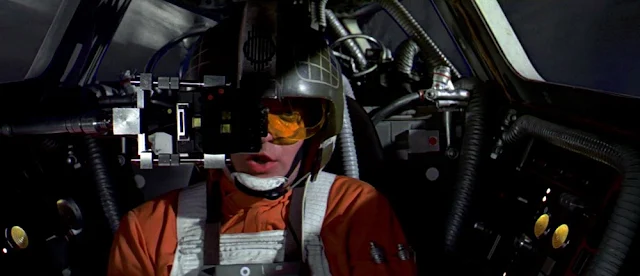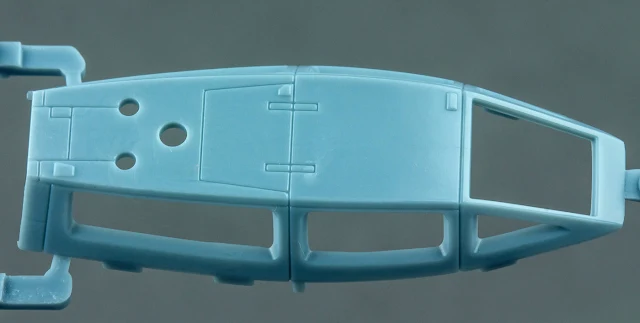With all of the hype surrounding the new Star Wars movies it's hard to ignore the tie-ins (no pun intended) on the market right now and that extends to models - lucky for us... Having built both the AT-ST and R2-D2 kits from FineMolds
Andy Moore is well versed to talk about their new star wars themed kits. Today
he looks at the 1/72nd scale Y-Wing Fighter from this Japanese model
maker – See what he thinks of it in today's in-box…
BTL-A4 Y-Wing
Starfighter
Bandai
Kit no. 0196694
Scale: 1/72
Price: ¥2,720 / US $21.97 / £14.02 / €19.62 from HobbyLink Japan (Cheapest
we could find)
Bandai have been pretty busy since acquiring the Star Wars
licence last year with a growing collection of vehicles and figures in their
range. At first, many, myself included, were a little sceptical of what they
would produce, given the high standard set by the previous licence holder, FineMolds,
but we needn't have worried. Their releases so far have been to a very high
standard (check out Clayton's fantastic AT-ST build for proof), so let's see if
their latest release lives up to those standards.
The Y-Wing was a heavy fighter-bomber used by the Rebel
Alliance, appearing first in “A New Hope” alongside the iconic X-Wing and, like
that other famous Star Wars fighter, it's name was derived from its resemblance
to a capitol letter.
The kit arrived in a nice glossy box with an illustration of
a Y-Wing skimming the surface of the Death Star pursued by an Imperial TIE. The
box sides would appear to have plenty of info on the kit but, as it's all in
Japanese, I haven't a clue what it says. So lets leave the box behind and get
down to business.
There's 10 sprues inside in a variety of colours, including
one with Bandai's trademark multi-coloured moulding. It's worth stating up
front that these Bandai kits are snap fix, but don't let that put you off.
These aren't like the snap fix kits of yore, with sloppy fit and poor moulding.
These kits are state of the art with exceptionally well-engineered parts that
fit flawlessly and are moulded in the appropriate colours meaning they can be built
strait from the box without glue or paint should you wish. Of course, they can
also be treated just like any regular model, and fully painted and weathered.
Sprue A
This is the multi-coloured sprue with parts for the engine
nacelles in pale grey, engine and cockpit components in black, the stripes for
the nose in yellow and also the clear parts in, you guessed it, clear.
Sprue B1
This is mainly parts for the rear fuselage, moulded in pale
grey. There's some extraordinary details here which we'll look at more closely
further down.
Sprue B2
This one's got the cockpit halves, split top and bottom with
the sides moulded integrally with the top. The resulting seam falls along a
panel line, so there should be no need for filling. This sprue's also got the
small stub wings and the three, yes three, pilots. More on them later.
Sprue C
This is all the plumbing that covers the Y-Wing's fuselage.
Some of these parts are very thin and will need some care when cutting them off
the sprue. Fortunately, there's very little in the way of mould lines on them,
so they shouldn't need much clean up.
Sprue D (x2)
Here we've got the pylons that connect the steering vanes to
the nacelles, along with the vanes themselves and their shrouds. This is also
were we find a couple of familiar looking droids, one designed to fit in the
droid socket in the fuselage and another that's free standing. Two domes are
included for the droids, one for an R2 unit and the other for an R5.
Sprue E1
Just three parts here, the canopy frame and end caps for the
nacelles, moulded in a blue grey to match the colour on the studio models.
Sprue E2
All slide moulded parts on this sprue. The two main guns,
which feature drilled out ends, and a detail part for the rear fuselage.
Sprue SWB6
This is the stand, if you decide to have the Y in flight,
moulded to replicate a section of Death Star surface. The base is designed to
interlock with those supplied with the other Star Wars craft.
Sprue SWE1
The two, optional, clear red, laser blasts that fit into the
main guns. These seem to be a standard feature of Bandai's Star Wars releases and
add a bit of drama if you're inclined to use them.
And now, let’s have a closer look at the parts starting with
the cockpit. In terms of detail, this is as good as you'd get with the best
aircraft kits in this scale. It's hard to say how accurate it is but it's
certainly busy and will look great once painted and with a wash applied.
The instrument panel, by comparison, is a little basic, but
there's a reasonable, if slightly pixelated, decal provided as an alternative,
although you'll probably need to remove the moulded detail to use it.
There's still room for some additional detailing as the
cockpit set used for filming had a lot of extra hoses and cabling. The
prominent targeting computer hasn't been included, so that's another addition
that could be made.
The forward fuselage is in two parts and most of the raised
details seem to match the originals pretty closely. The decision to supply the
yellow stripe as a separate piece has avoided the need for a decal, but it will
result in a panel line were there shouldn't be one.
The rear bulkhead is very well detailed but there's no
glazing included for the rear window and that leads us onto the only real
problem with the kit...
...that being the canopy, or canopies, as there are two
supplied. The first is used for the closed option and features just the frame,
moulded in pale blue.
The second canopy is for the open option. This one's split
into three parts with the middle open section featuring a tab on the lower
frame the sits into the cockpit surround fixing the canopy at the correct
angle. These parts are moulded in clear plastic and feature the frame and
glazing in one.
The decision to do the canopies this way means that there's
no glazing provided for the closed option. It's true that many of the original
studio models didn't feature glazing but this was a filming practicality to
avoid unwanted reflections of the lights and cameras, not because ILM thought
that the ships would fly around in space without any windows.
If you want to build the ship with a closed, glazed, canopy,
you'll either have to modify the clear parts or add some acetate glazing to the
canopy frame.
The top and bottom halves of the main fuselage feature a
mass of finely moulded detail. These are a marked step up in detail compared to
the previous FineMolds offering.
The panels that make up the engine nacelles also feature
some amazingly fine detail. In the zoomed-in area shown below, the small brick
shapes are less than 0.4 mm wide.
The end caps for the nacelles have a nice representation of
the forward part of the engine. Although this is covered by the radome, the
snap fix nature of the kit means the cover can be removed to display the
detail.
As mentioned earlier, you get three pilot figures in the
box; one standing, and two seated options for the cockpit. The standing figure
is based on a Y-Wing pilot from episode 4 (ANH) and wears the regular orange
flight suit similar to an X-Wing pilot.
One of the seated pilots also wears this suit while the other has the flight suit used in Episode 6 (ROTJ).
Last to mention are the Astromechs. Again, these are
extraordinarily well detailed considering their size. The only down side here is
the lack of any decals for the various body panels so painting them will need
either a very steady hand or some fiddly masking.
The marking are supplied in both water slide and sticker
form and are fairly minimal and not that well printed with noticeable pattering
on some areas of flat colour. It's also worth noting that, unlike the FineMolds
release, you don't get any decals to represent the scuffs and scrapes and other
assorted battle damage on the hull.
The instruction sheet is typical of previous Bandai releases
but, rather than being in book form, folds out into a rather cumbersome
poster-sized sheet.
I'll lay my cards on the table right up front; this is one
of the best moulded kits I've ever seen. Some of the detailing that Bandai have
achieved is amazing. That being said, there are a couple of disappointments,
the main one being the lack of glazing for the closed canopy option. The
relatively poor decals are another, especially the lack of markings for the
astromechs, something that FineMolds did include with their releases.
All in all though, this is a spectacular release and easily
the best Y-Wing produced to date. I've no doubt it will go together as well as
it looks, but we'll find out for sure when I get onto construction.
Stay tuned
Andy Moore
For more on Bandai's kits - take a look at their Website































